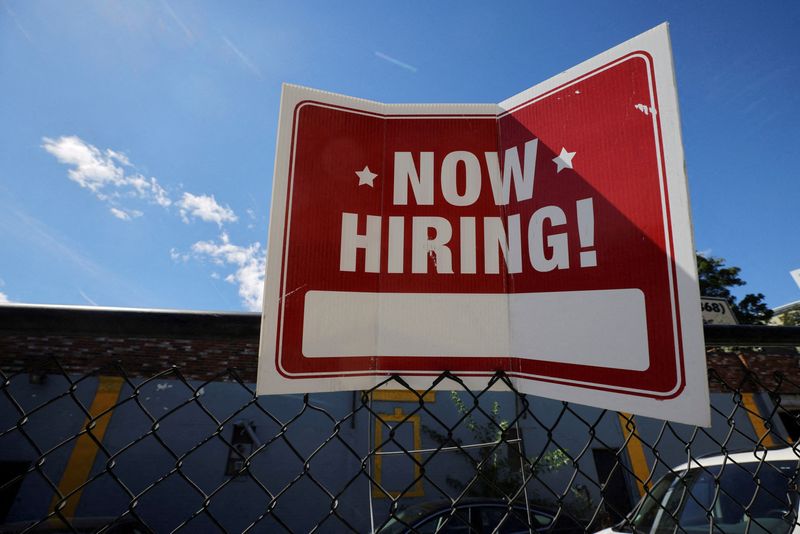US job growth probably slowed in October due to UAW strike
2023.11.03 00:46
4/4

© Reuters. FILE PHOTO: FILE PHOTO: A “now hiring” sign is displayed outside Taylor Party and Equipment Rentals in Somerville, Massachusetts, U.S., September 1, 2022. REUTERS/Brian Snyder/File Photo
2/4
By Lucia Mutikani
WASHINGTON (Reuters) – U.S. job growth likely slowed in October partly due to strikes by the United Auto Workers (UAW) union against Detroit’s “Big Three” car makers, which depressed manufacturing payrolls.
The anticipated moderation in employment growth last month would also be pay back after September’s enormous gains, the largest in eight months.
The Labor Department’s closely watched employment report on Friday is expected to show labor market conditions steadily easing, with annual wage growth the smallest in nearly 2-1/2 years and significant growth in the supply of workers.
The report could bolster the view that the Federal Reserve need not raise interest rates further. The U.S. central bank held rates unchanged on Wednesday but left the door open to a further increase, a nod to the economy’s resilience.
“The hiring figures will ultimately be somewhat depressed by strike activity, though the labor market is still likely to remain quite tight,” said Sam Bullard, a senior economist at Wells Fargo in Charlotte, North Carolina.
The Labor Department’s Bureau of Labor Statistics (BLS) is likely to report that nonfarm payrolls increased by 180,000 jobs last month after surging 336,000 in September, according to a Reuters survey of economists. Manufacturing payrolls are forecast falling 10,000 after advancing 17,000 in September.
Last week, the BLS reported at least 30,000 UAW members were on strike during the period it surveyed businesses for October’s employment report. The strikes have since ended, which could provide a lift to November’s payrolls.
Government employment, a big driver of payroll gains in September as state and local governments recruited for the new school year, likely moderated last month. Technical factors, related to the model used to strip out seasonal fluctuations from data, could affect the payrolls count.
“There is a large downward seasonal adjustment to payrolls in October, around 900,000,” said Veronica Clark, an economist at Citigroup in New York. “This would imply weakness in seasonally adjusted figures if the usual increase in employment, which typically occurs ahead of the holiday season, is not as large as normal. Anecdotes from various companies have suggested holiday season hiring should still be robust this year.”
RESILIENT ECONOMY
The labor market was the major force pushing third-quarter U.S. gross domestic product growth to nearly 5%.
The unemployment rate is seen steady at 3.8%. But the jobless rate could still tick higher with more people entering the labor force due partly to confidence in availability of work and worries of an economic slowdown next year.
The expanding labor pool and fewer people changing jobs mean easing wage pressures.
Average hourly earnings were forecast to climb 0.3%, matching September’s rise. That would lower the annual increase in wages to 4.0%, the smallest gain since June 2021, from 4.2% in September. Wages gains would still be above the 3.5% that economists say is consistent with the Fed’s 2% target.
Though wages have not been the main driver of inflation, some economists worry recent hefty contracts, including the ones scored by the UAW, airline pilots and the union representing UPS workers, could complicate the Fed’s fight against inflation.
They said the recent surge in worker productivity would not be enough to offset higher compensation as the economy was now predominantly services.
“Historically, we’ve been getting productivity gains out of manufacturing, but manufacturing is becoming a smaller and smaller share of the total pie,” said Sung Won Sohn, Finance and Economics professor at Loyola Marymount University in Los Angeles. “We will see wage inflation becoming more of a problem, I wouldn’t say wage price spiral, but certainly that is one of the reasons why we’re not going to see a significant slowdown in the inflation rate from where we are.”
Others disagreed, saying the hefty contracts would only become an issue for wage inflation if the Fed raised rates too high and choked off demand. They viewed the UAW contract as getting wages in the auto sector more aligned with the surge productivity during the COVID-19 pandemic.
“If they have a multi-year agreement, which says that they want wages to rise by 6% or 7%, then you need to generate the productivity gains to support it,” said Brian Bethune, an Economics professor at Boston College.
“If the Fed slows down the economy too much, that’s not going to happen, and we will end up in trap of slow demand, low productivity and high unit labor costs.”








